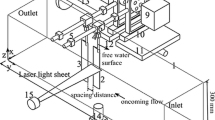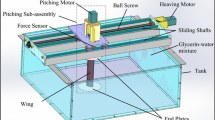Abstract
Lagrangian Coherent Structures (LCS) of tandem wings hovering in an inclined stroke plane is studied using Immersed-Boundary Method (IBM) by solving two dimensional (2D) incompressible Navier-Stokes equations. Coherent structures responsible for the force variation are visualized by calculating Finite Time Lyapunov Exponents (FTLE), and vorticity contours. LCS is effective in determining the vortex boundaries, flow separation, and the wing-vortex interactions accurately. The effects of inter-wing distance and phase difference on the force generation are studied. Results show that in-phase stroking generates maximum vertical force and counter-stroking generates the least vertical force. In-phase stroking generates a wake with swirl, and counter stroking generates a wake with predominant vertical velocity. Counter stroking aids the stability of the body in hovering. As the hindwing operates in the wake of the forewing, due to the reduction in the effective Angle of Attack (AoA), the hindwing generates lesser force than that of a single flapping wing.
Similar content being viewed by others
References
Ellington C P, van den Berg C, Willmott A P, Thomas A L R. Leading-edge vortices in insect flight. Nature, 1996, 384, 626–630.
Shyy W, Liu H. Flapping wings and aerodynamic lift: The role of leading-edge vortices. AIAA Journal, 2007, 45, 2817–2819.
Jeong J, Hussain F. On the identification of a vortex. Journal of Fluid Mechanics, 1995, 285, 69–94.
Green M A, Rowley C W, Smits A J. Using hyperbolic La-grangian coherent structures to investigate vortices in bio-inspired fluid flows. Chaos, 2010, 20, 1–11.
Haller G, Yuan G. Lagrangian coherent structures and mixing in two-dimensional turbulence. Physica D: Nonlinear Phenomena, 2000, 147, 352–370.
Peacock T, Haller G. Lagrangian coherent structures: The hidden skeleton of fluid flows. Physics Today, 2013, 66, 41–47.
Haller G. Lagrangian coherent structures from approximate velocity data. Physics of Fluids, 2002, 14, 1851–1861.
Shadden S C, Lekien F, Marsden J E. Definition and properties of Lagrangian coherent structures from finite-time Lyapunov exponents in two-dimensional aperiodic flows. Physica D: Nonlinear Phenomena, 2005, 212, 271–304.
Haller G. An objective definition of a vortex. Journal of Fluid Mechanics, 2005, 525, 1–26.
Eldredge J D, Chong K. Fluid transport and coherent struc-tures of translating and flapping wings. Chaos, 2010, 20, 1–40.
Peng J, Dabiri J O. An overview of a Lagrangian method for analysis of animal wake dynamics. The Journal of experimental biology, 2008, 211, 280–287.
Brunton S L, Rowley C W. Modeling the unsteady aerodynamic forces on small-scale wings. AIAA Paper, 2009, 2009-1127, 1–14.
Wan H, Dong H, Beran P. Wake coherent structure of hovering flapping wings. 28th AIAA Applied Aerodynamics Conference, Chicago, Illinois, USA, 2010, 1–10.
Yang A, Jia L, Yin X. Experimental study of a starting vortex ring generated by a thin circular disk. Journal of Bionic Engineering, 2010, 7, S103–S108.
Rosti M E, Omidyeganeh M, Pinelli A. Direct numerical simulation of the flow around an aerofoil in ramp-up motion. Physics of Fluids, 2016, 28, 025106.
Lan S L, Sun M. Aerodynamic properties of a wing per-forming unsteady rotational motions at low Reynolds number. Acta Mechanica, 2001, 149, 135–147.
Wang Z J, Russell D. Effect of forewing and hindwing in-teractions on aerodynamic forces and power in hovering dragonfly flight. Physical Review Letters, 2007, 99, 1–4.
Shen C, Sun M. Power requirements of vertical flight in the dronefly. Journal of Bionic Engineering, 2015, 12, 227–237.
Usherwood J R, Lehmann F O. Phasing of dragonfly wings can improve aerodynamic efficiency by removing swirl. Journal of the Royal Society Interface, 2008, 5, 1303–1307.
Xiang J, Du J, Li D, Liu K. Aerodynamic performance of the locust wing in gliding mode at low Reynolds number. Journal of Bionic Engineering, 2016, 13, 249–260.
Broering T M, Lian Y S. The effect of phase angle and wing spacing on tandem flapping wings. Acta Mechanica Sinica/Lixue Xuebao, 2012, 28, 1–15.
Broering T M, Lian Y. Numerical study of tandem flapping wing aerodynamics in both two and three dimensions. Computers and Fluids, 2015, 115, 124–139.
Taira K, Colonius T. The immersed boundary method: A projection approach. Journal of Computational Physics, 2007, 225, 2118–2137.
Wang Z J. The role of drag in insect hovering. Journal of Experimental Biology, 2004, 207, 4147–4155.
Gao T, Lu X Y. Insect normal hovering flight in ground effect. Physics of Fluids, 2008, 20, 087101.
Xu S, Wang Z J. An immersed interface method for simulating the interaction of a fluid with moving boundaries. Journal of Computational Physics, 2006, 216, 454–493.
Childs H, Brugger E, Whitlock B, Meredith J, Ahern S, Pugmire D, Biagas K, Miller M, Harrison C, Weber G H, Krishnan H, Fogal T, Sanderson A, Garth C, Bethel E W, Durant M, Camp D, Favre J M, Rübel O, Navrátil P. Wheeler M, Selby P, Vivodtzev F. VisIt: An end-user tool for visualizing and analyzing very large data. In Bethel E W, Childs H (eds.), High Performance Visualization-Enabling Extreme-Scale Scientific Insight, Chapman and Hall/CRC, London, UK, 2012, 357–372.
Meng X, Sun M. Wing kinematics, aerodynamic forces and vortex-wake structures in fruit-flies in forward flight. Journal of Bionic Engineering, 2016, 13, 478–490.
Author information
Authors and Affiliations
Corresponding author
Rights and permissions
About this article
Cite this article
Gadde, S.N., Vengadesan, S. Lagrangian coherent structures in tandem flapping wing hovering. J Bionic Eng 14, 307–316 (2017). https://doi.org/10.1016/S1672-6529(16)60399-2
Published:
Issue Date:
DOI: https://doi.org/10.1016/S1672-6529(16)60399-2




